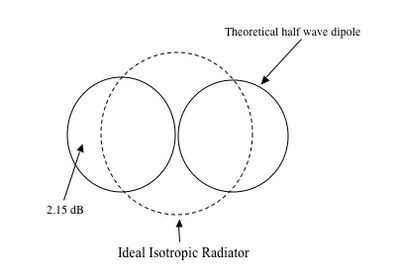Gain: Difference between revisions
No edit summary |
|||
| Line 30: | Line 30: | ||
hence, <math> dBi = dBD + 2.15 </math> | hence, <math> dBi = dBD + 2.15 </math> | ||
{{electronics}} | |||
Revision as of 17:17, 8 April 2009
Related wiki pages Antennas, Antenna Design, Decibels, Radiated Power Measurement, SWR
What is Gain?
Gain compared to a half wave dipole - dBD
The gain of an antenna is the relative increase in radiation at the maximum point expressed as a value in dB above a standard. The standard to which other antennas are compared is usually a ½-wavelength dipole. The standard antenna is given a reference gain of 0dBD (zero decibel referenced to dipole). This comes from:
<math> \mbox{gain} = 10 \times \log \left( \frac {Pe}{Pi} \right) </math>
Where Pe is effective radiated power and Pi is input power
An antenna with the effective radiated power of three times the input power would therefore have a gain of:
Pe = 3, Pi = 1
<math> 10 \times \log \left( \frac {3}{1} \right) = 4.77\mbox{dBD} </math>
Gain compared to an isotropic readiator = dBi
An isotropic radiator is a theoretical "point source" antenna that radiates the same amount of energy in all directions. Although an isotropic antenna cannot be constructed, it is sometimes useful to compare actual antennas to it.
Comparison of dBD and dBi
Graphically, the radiation patterns of isotropic and dipole antennas - for equal power inputs - can be represented thus:
The area between the isotropic radiator circle and the half wave circle radiator circle represents a gain difference of approximately 2.15dB
hence, <math> dBi = dBD + 2.15 </math>
| Electronic Theory | |
| Physical quantities | Current * Gain * Impedance * Power * Q of a circuit * Radiated Power Measurement * Reactance* Resistivity * Resonance * Voltage |
| Components | Baluns * Bipolar-Junction Transistors * Capacitors * Diodes * Inductors* Lasers * Microphones * Resistors * Transformers * Wire |
| Circuits | Attenuators * Digital Signal Processing (DSP) * Dummy load * Filters * LC filters * Power Supply Design * Rectifier Circuits |
| Design | Amplifier Design * Oscillator Design |
| Electromagnetic Waves | Relative power (Decibels) * Harmonics * Interference and BPL |
